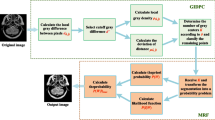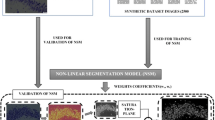Abstract
The brain consists of massive regions with different functions and the precise delineation of brain region boundaries is important for brain region identification and atlas illustration. In this paper we propose a hierarchical Markov random field (MRF) model for brain region segmentation, where a MRF is applied to the downsampled low-resolution images and the result is used to initialize another MRF for the original high-resolution images. A fractional differential feature and a gray level co-occurrence matrix are extracted as the observed vector for the MRF and a new potential energy function, which can capture the spatial characteristic of brain regions, is proposed as well. A fuzzy entropy criterion is used to fine-tune the boundary from the hierarchical MRF model. We test the model both on synthetic images and real histological mouse brain images. The result suggests that the model can accurately identify target regions and even the whole mouse brain outline as a special case. An interesting observation is that the model cannot only segment regions with different cell density but also can segment regions with similar cell density and different cell morphology texture. Thus this model shows great potential for building the high-resolution 3D brain atlas.












Similar content being viewed by others
References
Balafar, M. A., Ramli, A. R., Saripan, M. I., & Mashohor, S. (2010). Review of brain MRI image segmentation methods. Artificial Intelligence Review, 33(3), 261–274.
Brodmann, K. (1908). Beiträge zur histologischen lokalisation der groβhirnrinde. Journal für Psychologie und Neurologie, 10, 231–246.
Brunjes, P. C., Illig, K. R., & Meyer, E. A. (2005). A field guide to the anterior olfactory nucleus (cortex). Brain Research Reviews, 50(2), 305–335.
Chandgotia, & Nishant. (2017). Generalisation of the Hammersley-Clifford theorem on bipartite graphs. Transactions of the American Mathematical Society, 369(10), 7107–7137.
David, S. A., Linares, J. L., & Pallone, E. M. (2011). Fractional order calculus: Historical apologia, basic concepts and some applications. Revista Brasileira de Ensino de Física, 33(4), 4302–4302.
De Luca, A., & Termini, S. (1972). A definition of a nonprobabilistic entropy in the setting of fuzzy sets theory. Information and Control, 20(4), 301–312.
Der Lijn, F. V., Den Heijer, T., Breteler, M. M., & Niessen, W. J. (2008). Hippocampus segmentation in MR images using atlas registration, voxel classification, and graph cuts. Neuroimage, 43(4), 708–720.
Derin, H., Elliott, H., Cristi, R., & Geman, D. (1984). Bayes smoothing algorithms for segmentation of binary images modeled by Markov random fields. IEEE Transactions on Pattern Analysis and Machine Intelligence, 6, 707–720.
Dong, H. W. (2008). The Allen reference atlas: A digital color brain atlas of the C57Bl/6J male mouse. Wiley..
Dorr, A. E., Lerch, J. P., Spring, S., Kabani, N., & Henkelman, R. M. (2008). High resolution three-dimensional brain atlas using an average magnetic resonance image of 40 adult C57Bl/6J mice. NeuroImage, 42(1), 60–69.
Economo, M. N., Clack, N. G., Lavis, L. D., Gerfen, C. R., Svoboda, K., Myers, E. W., & Chandrashekar, J. (2016). A platform for brain-wide imaging and reconstruction of individual neurons. Elife, 5, e10566.
Feng, Z., Li, A., Gong, H., & Luo, Q. (2016). An automatic method for nucleus boundary segmentation based on a closed cubic spline. Frontiers in Neuroinformatics, 10, 21.
Franklin, K. B. J., & Paxinos, G. (2004). The mouse brain: In stereotaxic coordinates. Rat Brain in Stereotaxic Coordinates, 3(2), 6.
Gahr, M. (1997). How should brain nuclei be delineated? Consequences for developmental mechanisms and for correlations ofarea size, neuron numbers and functions of brain nuclei. Trends in Neurosciences, 20(2), 58–62.
Gong, H., Zeng, S., Yan, C., Lv, X., Yang, Z., Xu, T., Feng, Z., Ding, W., Qi, X., Li, A., & Wu, J. (2013). Continuously tracing brain-wide long-distance axonal projections in mice at a one-micron voxel resolution. Neuroimage, 74, 87–98.
Gong, H., Xu, D., Yuan, J., Li, X., Guo, C., Peng, J., Li, Y., Schwarz, L. A., Li, A., Hu, B., & Xiong, B. (2016). High-throughput dual-colour precision imaging for brain-wide connectome with cytoarchitectonic landmarks at the cellular level. Nature Communications, 7, 12142.
Gonzalez, R. C., Woods R. E., & Eddins S. L. (2004). Digital image processing using Matlab. Pearson Prentice Hall.
Gottsegen, C. J., Merkle, A. N., Bencardino, J. T., & Gyftopoulos, S. (2017). Advanced MRI techniques of the shoulder joint: Current applications in clinical practice. American Journal of Roentgenology, 209(3), 544–551.
Guo, C., Peng, J., Zhang, Y., Li, A., Li, Y., Yuan, J., Xu, X., Ren, M., Gong, H., & Chen, S. (2017). Single-axon level morphological analysis of corticofugal projection neurons in mouse barrel field. Scientific Reports, 7(1), 2846.
Haralick, R. M., & Shanmugam, K. (1973). Textural features for image classification. IEEE Transactions on Systems, Man, and Cybernetics, 6, 610–621.
Johnson, G. A., Badea, A., Brandenburg, J., Cofer, G., Fubara, B., Liu, S., & Nissanov, J. (2010). Waxholm space: An image-based reference for coordinating mouse brain research. Neuroimage, 53(2), 365–372.
Kemper, V. G., De Martino, F., Emmerling, T. C., Yacoub, E., & Goebel, R. (2018). High resolution data analysis strategies for mesoscale human functional MRI at 7 and 9.4 T. Neuroimage, 164, 48–58.
Li, A., Gong, H., Zhang, B., Wang, Q., Yan, C., Wu, J., Liu, Q., Zeng, S., & Luo, Q. (2010). Micro-optical sectioning tomography to obtain a high-resolution atlas of the mouse brain. Science, 330(6009), 1404–1408.
Li, Y., Gong, H., Yang, X., Yuan, J., Jiang, T., Li, X., Sun, Q., Zhu, D., Wang, Z., Luo, Q., & Li, A. (2017). TDat: An efficient platform for processing petabyte-scale whole-brain volumetric images. Frontiers in Neural Circuits, 11, 51.
Maksimovic, R., Stankovic, S., & Milovanovic, D. (2000). Computed tomography image analyzer: 3D reconstruction and segmentation applying active contour models—‘snakes’. International Journal of Medical Informatics, 58, 29–37.
Marx, V. (2012). High-throughput anatomy: Charting the brain's networks. Nature, 490(7419), 293–298.
Mesejo, P., Ugolotti, R., Cagnoni, S., Di Cunto, F., & Giacobini, M. (2012). Automatic segmentation of hippocampus in histological images of mouse brains using deformable models and random forest. In 2012 25th IEEE International Symposium on Computer-Based Medical Systems (pp. 1–4).
Mesejo, P., Cagnoni, S., Costalunga, A., & Valeriani, D. (2013). Segmentation of histological images using a metaheuristic-based level set approach. In Genetic and Evolutionary Computation Conference Companion (pp. 1455–1462).
Meyer, E. A., Illig, K. R., & Brunjes, P. C. (2006). Differences in chemo-and cytoarchitectural features within pars principalis of the rat anterior olfactory nucleus suggest functional specialization. Journal of Comparative Neurology, 498(6), 786–795.
Mirzapour, F., & Ghassemian, H. (2013). Using GLCM and Gabor filters for classification of PAN images. In 2013 21st Iranian Conference on Electrical Engineering (pp. 1–6).
O'Rahilly, R., & Müller, F. (1983). Basic human anatomy: A regional study of human structure (p. 566). Philadelphia: Saunders.
Serrano, C., & Acha, B. (2009). Pattern analysis of dermoscopic images based on markov random fields. Pattern Recognition, 42(6), 1052–1057.
Umaselvi, M., Kumar, S. S., & Athithya, M. (2012). Color based urban and agricultural land classification by GLCM texture features. In IET Chennai 3rd International Conference on Sustainable Energy and Intelligent Systems (SEISCON 2012).
Wu, J., He, Y., Yang, Z., Guo, C., Luo, Q., Zhou, W., Chen, S., Li, A., Xiong, B., Jiang, T., & Gong, H. (2014). 3D BrainCV: Simultaneous visualization and analysis of cells and capillaries in a whole mouse brain with one-micron voxel resolution. Neuroimage, 87, 199–208.
Xiong, B., Li, A., Lou, Y., Chen, S., Long, B., Peng, J., Yang, Z., Xu, T., Yang, X., Li, X., & Jiang, T. (2017). Precise cerebral vascular atlas in stereotaxic coordinates of whole mouse brain. Frontiers in Neuroanatomy, 11, 128.
Yousif, O., & Ban, Y. (2014). Improving SAR-based urban change detection by combining MAP-MRF classifier and nonlocal means similarity weights. IEEE Journal of Selected Topics in Applied Earth Observations and Remote Sensing, 7(10), 4288–4300.
Acknowledgments
This research is supported by the 973 projection (Grant No.2015CB755602), Science Fund for Creative Research Group of China (Grant No.61721092) and National Natural Science Foundation of China (Grant No. 91749209). We appreciate Shangbin Chen, Chaozhen Tan and Hong Ning for constructive suggestions, Wu Chen and Zhenyu Pan for image analysis.
Author information
Authors and Affiliations
Corresponding author
Additional information
Publisher’s Note
Springer Nature remains neutral with regard to jurisdictional claims in published maps and institutional affiliations.
Rights and permissions
About this article
Cite this article
Xu, X., Guan, Y., Gong, H. et al. Automated Brain Region Segmentation for Single Cell Resolution Histological Images Based on Markov Random Field. Neuroinform 18, 181–197 (2020). https://doi.org/10.1007/s12021-019-09432-z
Published:
Issue Date:
DOI: https://doi.org/10.1007/s12021-019-09432-z




